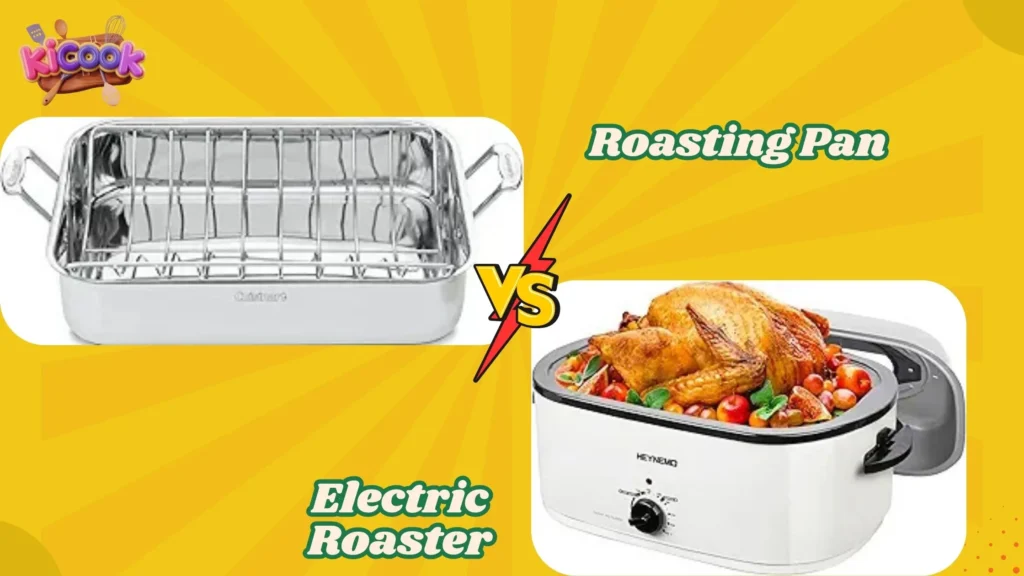When it comes to cooking, especially during the holidays or for large gatherings, the tools you use can make all the difference. I’ve spent years experimenting with both roasting pans and electric roasters, and I’ve learned that each has its own unique strengths and weaknesses. Whether you’re roasting a turkey for Thanksgiving or preparing a Sunday roast, choosing the right tool can save you time, energy, and stress.
In this article, I’ll share my experiences and insights to help you decide which one is the best fit for your kitchen.
Roasting Pan: The Classic Kitchen Essential

Let’s start with the roasting pan, a classic kitchen tool that has been a staple in homes for generations. A good roasting pan is like a trusty sidekick—it’s reliable, versatile, and always ready to help you create delicious meals.
“No one is born a great cook; one learns by doing.” – Julia Child
What I Love About My Roasting Pan
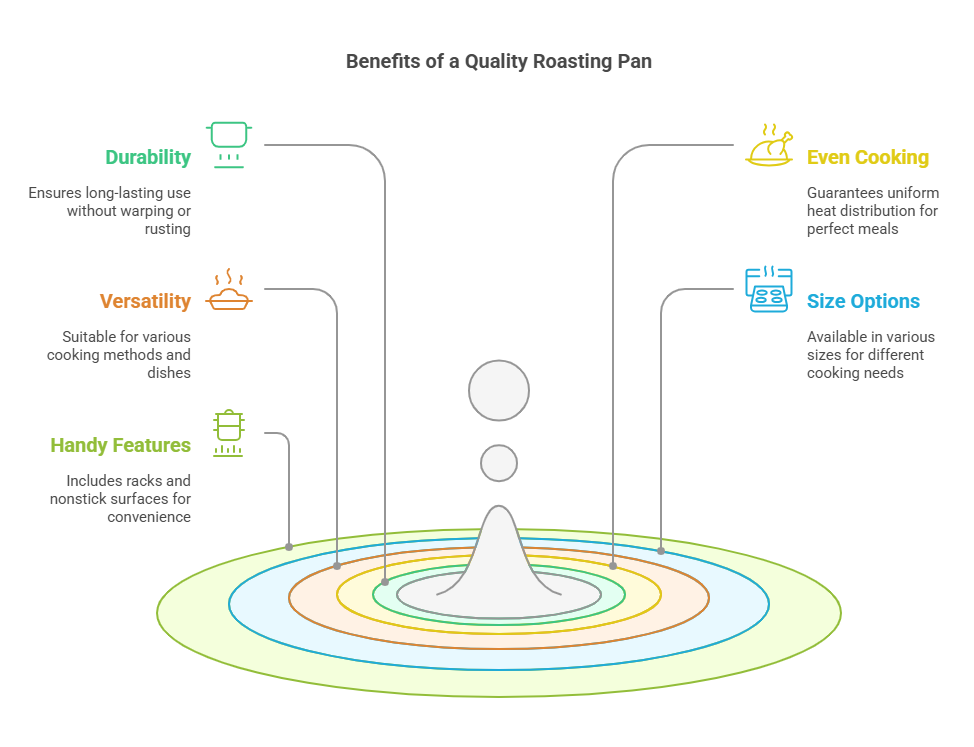
- Durability and Longevity: One of the things I appreciate most about my roasting pan is its durability. Made from high-quality stainless steel, it has stood the test of time. Unlike cheaper alternatives, it hasn’t warped or rusted, even after years of use. As Julia Child once said, “The only real stumbling block is fear of failure. In cooking, you’ve got to have a what-the-hell attitude.” And with a sturdy roasting pan, you can fearlessly tackle any recipe.
- Even Cooking: A good roasting pan ensures even heat distribution, which is crucial for achieving that perfect golden-brown crust on your roast. I’ve found that my stainless steel pan consistently delivers evenly cooked meals, whether I’m roasting a chicken or a batch of vegetables.
- Versatility: My roasting pan isn’t just for roasting. I’ve used it for everything from baking lasagna to making casseroles. Some models, like mine, can even be used on the stovetop, which is a game-changer when it comes to making gravy or pan sauces.
- The Right Size for Every Occasion: Roasting pans come in a variety of sizes, so you can choose one that fits your needs. Whether you’re cooking a small chicken or a 20-pound turkey, there’s a roasting pan that’s just the right size. My pan fits perfectly in my oven and suits my cooking style.
- Handy Features: Many roasting pans come with racks, which are great for lifting meat off the bottom of the pan and allowing air to circulate for even cooking. Nonstick surfaces are another bonus, making cleanup a breeze.
What Could Be Better
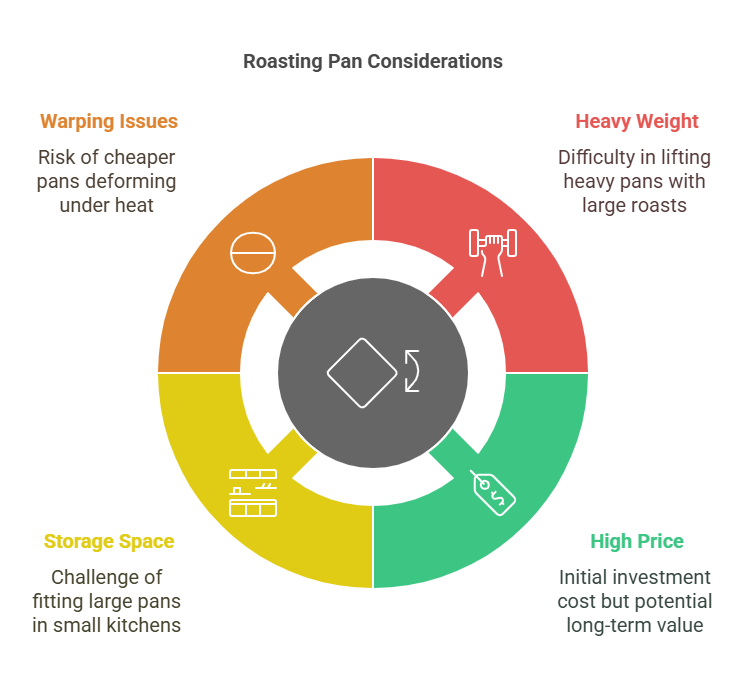
- Weight: High-quality roasting pans are heavy, and when you add a large roast or turkey, they can be difficult to lift. If you have trouble with heavy lifting, this could be a downside.
- Price: Good roasting pans aren’t cheap. When I first bought mine, I hesitated at the price, but over time, I’ve come to see it as a worthwhile investment.
- Storage: Roasting pans take up a lot of space. If you have a small kitchen, finding room for one can be a challenge.
- Warping Issues: Not all roasting pans are created equal. I once tried a cheaper model, and it warped under high heat. That experience taught me the importance of investing in quality.
My Roasting Adventures
Last Thanksgiving, I roasted a 15-pound turkey in my stainless steel roasting pan, and the results were fantastic—crispy skin and juicy meat. I also love using it for everyday meals, like roasting vegetables. Tossing carrots, potatoes, and Brussels sprouts with olive oil and herbs is one of my favorite ways to prepare a quick, healthy side dish. Cleanup is easy, thanks to the nonstick surface.
However, I’ve had my share of mishaps. That cheap pan I mentioned earlier? It warped, and my roast came out uneven. That’s when I truly appreciated the value of a high-quality roasting pan.
Should You Get a Roasting Pan?
Go for It If:
- You roast meat or vegetables often.
- You host holiday dinners.
- You love versatile kitchen tools that can handle a variety of tasks.
Skip It If:
- You rarely roast.
- Your kitchen is already crowded with gadgets.
Tips for Choosing the Right Roasting Pan
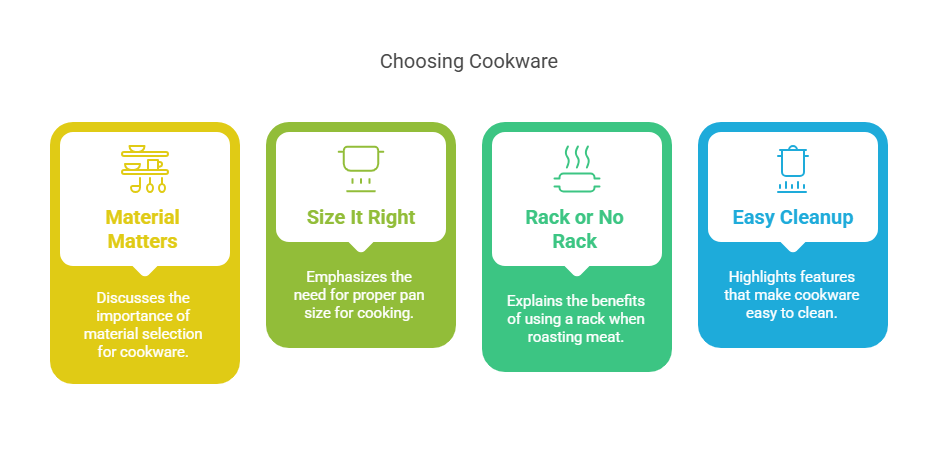
- Material Matters: Stainless steel is durable and long-lasting, while cast aluminum heats up faster. Choose the material that best suits your cooking style.
- Size It Right: Make sure the pan fits your oven and your typical cooking needs. A pan that’s too large or too small can be awkward to use.
- Rack or No Rack: If you roast meat often, a rack is a must. It helps elevate the meat for even cooking and crispier results.
- Easy Cleanup: Look for nonstick options and check if the pan is dishwasher-safe.
Investing in a good roasting pan was one of the best decisions I’ve made for my kitchen. It’s reliable, versatile, and built to last. If you’re on the fence, I’d say go for it—you won’t regret it.
“The kitchen is a laboratory, and everything that happens there has to do with science.” – Alton Brown
Electric Roaster: The Holiday Meal MVP

Now, let’s talk about electric roasters. These handy appliances are a lifesaver, especially during the holidays. They take the stress out of cooking large meals and free up your oven for other dishes. If you’ve ever struggled to juggle multiple dishes on Thanksgiving, an electric roaster might just be your new best friend.
What Makes Electric Roasters So Great?
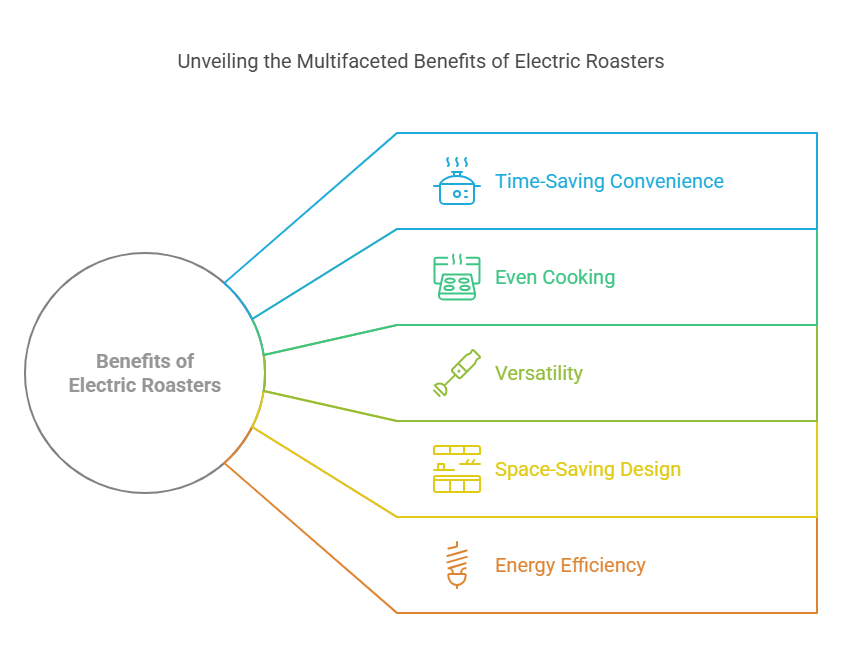
- Time-Saving Convenience: One of the biggest advantages of an electric roaster is the convenience it offers. Imagine it’s Thanksgiving morning, and your turkey is cooking in the electric roaster while you focus on side dishes and desserts. No constant checking, no stress—it’s like having an extra set of hands in the kitchen.
- Even Cooking: Electric roasters are designed to cook food evenly. Whether you’re roasting a turkey, a ham, or a beef roast, you can count on juicy, evenly cooked results without dry edges or undercooked spots.
- Versatility: Electric roasters aren’t just for roasting. They can also bake, slow-cook, and even keep food warm. Need to make a casserole or stew? Your electric roaster has you covered. It’s like having a versatile kitchen buddy that can handle a variety of tasks.
- Space-Saving Design: For those with small kitchens, electric roasters are a blessing. They’re compact but still large enough to handle a holiday turkey. Plus, they free up your oven for other dishes, which is a huge advantage during busy cooking times.
- Energy Efficiency: Why heat your entire oven for hours when you can use an electric roaster? These appliances use less energy, which is good for your wallet and the environment.
A Few Things to Keep in Mind
- Limited Capacity for Large Crowds: While electric roasters are great for medium-sized gatherings, they might not be enough if you’re hosting a huge crowd. For 30 or more guests, you may need more than one roaster.
- Temperature Control: Some electric roasters lack precise temperature controls, which can make it tricky to achieve crispy skin or exact cooking results. You may need to keep a close eye on your food or use a meat thermometer to ensure it’s cooked to perfection.
- Build Quality: Not all electric roasters are created equal. Some models have flimsy lids or handles, so it’s important to read reviews and choose a sturdy, well-built model.
- Cleaning: While most electric roasters have removable pans, cleaning can still be a bit of a hassle. Lining the pan with foil can make cleanup easier, but it’s still something to keep in mind.
My Electric Roaster Adventures
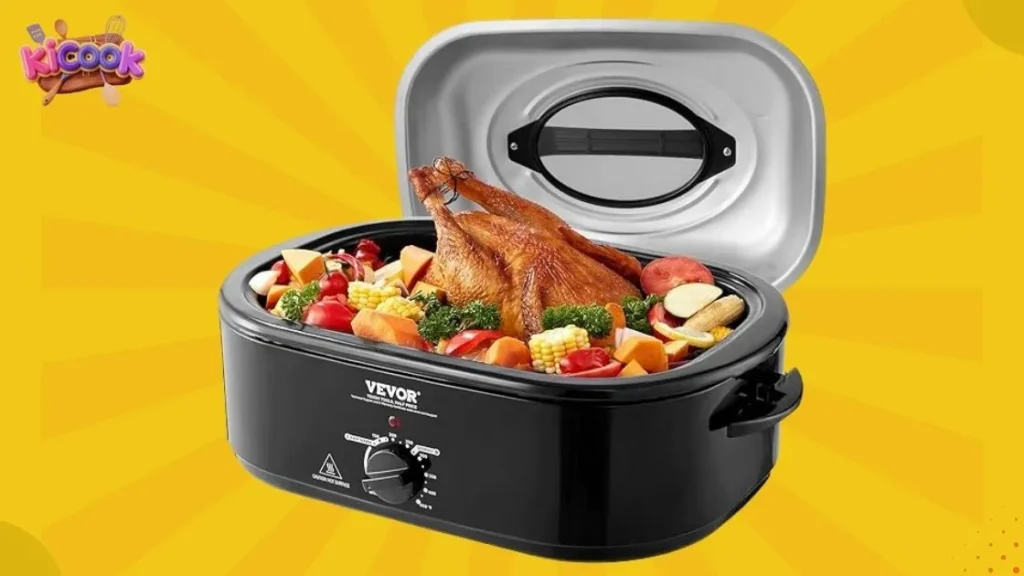
Last Thanksgiving, I used my Proctor Silex 32211 electric roaster to cook a 24-pound turkey, and the results were amazing. The self-basting lid kept the meat juicy without any extra effort on my part, and my oven was free for desserts and casseroles. It was a game-changer for my holiday cooking.
I’ve also used my Sunvivi 18QT roaster to slow-cook a beef brisket for a family reunion. The meat came out tender and flavorful, though I did have to keep an eye on the temperature since the controls weren’t as precise as I would have liked.
Is an Electric Roaster Right for You?
Perfect If You:
- Host holiday meals or medium-sized gatherings.
- Want to save oven space and simplify cooking.
- Love multi-purpose kitchen tools.
Maybe Not If You:
- Cook for very large crowds.
- Need precise temperature control.
- Prefer lightweight, easy-to-clean appliances.
Tips for Roasting Success
- Preheat for Perfection: Always preheat your electric roaster for even cooking.
- Use a Thermometer: Check the internal temperature of your meat to avoid overcooking.
- Line the Pan: Use foil or parchment paper to make cleanup easier.
Electric roasters are a secret weapon for holiday cooking. They’re versatile, efficient, and save so much time. While they’re not perfect, the pros far outweigh the cons. If you want to make your holiday meals easier, an electric roaster is a great choice.
“Cooking is an art, but all art requires knowing something about the techniques and materials.” – Nathan Myhrvold
Roasting Pan vs Electric Roaster: Key Comparison
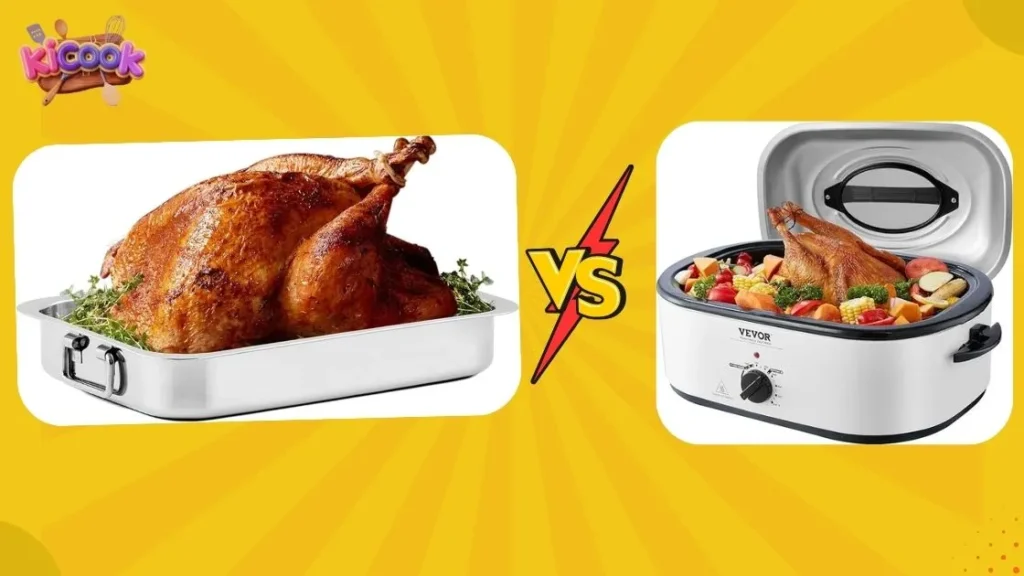
Choosing between a roasting pan and an electric roaster can be tricky. Both have unique strengths, and your choice depends on your cooking style and needs. Let’s break it down to see how these options compare across key features.
Heat Distribution: Roasting Pan vs Electric Roaster
Heat distribution is crucial for cooking consistency. Roasting pans rely on your oven’s heat, while electric roasters have built-in heating elements.
| Feature | Roasting Pan | Electric Roaster |
|---|---|---|
| Heat Source | Oven-based | Built-in electric heating |
| Heat Consistency | Depends on oven quality | Generally consistent |
| Preheating Requirement | Requires oven preheating | Heats up faster without an oven |
Winner: Electric Roaster. Its built-in heating provides consistent results without relying on external appliances.
Capacity: Roasting Pan vs Electric Roaster
Capacity is important for large meals, especially during the holidays.
| Feature | Roasting Pan | Electric Roaster |
|---|---|---|
| Typical Size | Varies (8-16 quarts) | Typically larger (18-22 quarts) |
| Best For | Smaller turkeys or roasts | Large turkeys or batch cooking |
| Portability | Limited; tied to the oven | Portable; plug-in and use anywhere |
Winner: Electric Roaster. Its size and portability make it ideal for big meals and flexible usage.
Versatility: Roasting Pan vs Electric Roaster
Both options offer versatility, but the scope differs.
| Feature | Roasting Pan | Electric Roaster |
|---|---|---|
| Cooking Methods | Roasting, baking, broiling | Roasting, baking, slow cooking |
| Additional Uses | Can double as a serving dish | Can keep food warm for serving |
| Ease of Cleaning | Dishwasher-safe for most | Usually requires hand washing |
Winner: Electric Roaster. It’s multifunctional, offering more cooking options.
Performance: Roasting Pan vs Electric Roaster
Performance depends on the cooking task. The electric roaster’s design leads to faster, more efficient results.
| Feature | Roasting Pan | Electric Roaster |
|---|---|---|
| Cooking Time | Longer, depending on oven | Faster due to efficient heat circulation |
| Even Cooking | Relies on oven quality | More uniform heating |
| Energy Efficiency | Less efficient; uses full oven energy | More energy-efficient |
Winner: Electric Roaster. Faster cooking and energy efficiency give it an edge.
Ease of Use: Roasting Pan vs Electric Roaster
Ease of use affects your overall cooking experience.
| Feature | Roasting Pan | Electric Roaster |
|---|---|---|
| Setup | Simple; place in the oven | Requires an outlet and counter space |
| Monitoring | Oven door must be opened periodically | Transparent lid allows easy monitoring |
| Storage | Compact; easy to store | Bulky; requires more storage space |
Winner: Roasting Pan. It’s simple to use and store, making it a practical choice for smaller kitchens.
Value for Money: Roasting Pan vs Electric Roaster
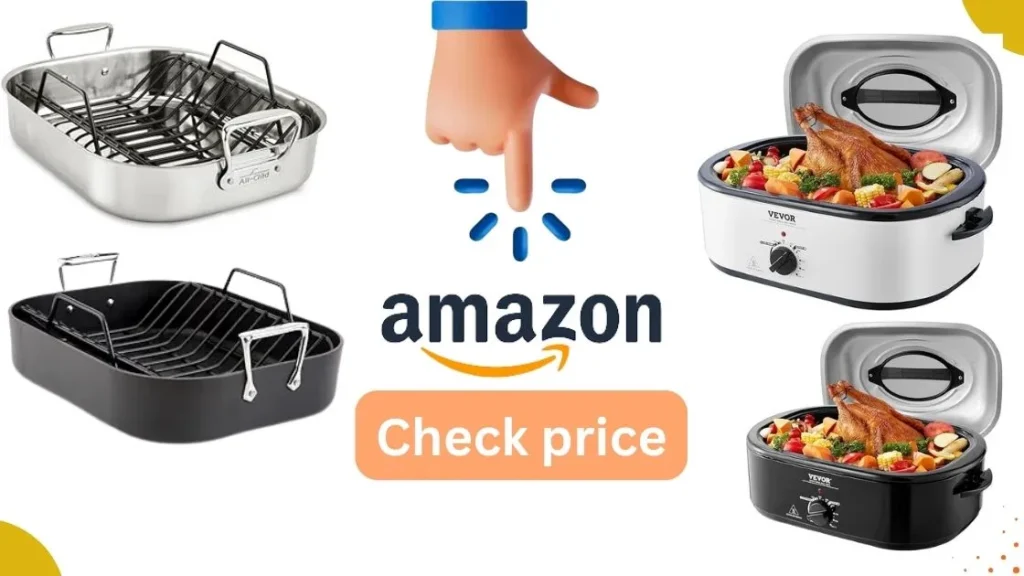
Cost and long-term value are essential factors.
| Feature | Roasting Pan | Electric Roaster |
|---|---|---|
| Price Range | Affordable; 20−20−100 | Moderate; 40−40−150 |
| Durability | Long-lasting with proper care | Long-lasting but may require repairs |
| Additional Costs | No extra power usage | Minor increase in electricity bills |
Winner: Roasting Pan. It’s affordable and cost-effective over time.
Overall: Roasting Pan vs Electric Roaster
Both options excel in different areas, so the winner depends on your needs.
| Feature | Roasting Pan | Electric Roaster |
|---|---|---|
| Best For | Occasional use; smaller meals | Frequent use; large meals or batch cooking |
| Maintenance | Easier to clean and store | Slightly more effort to maintain |
| Versatility | Great for oven-based dishes | Multifunctional; ideal for diverse recipes |
Winner: Electric Roaster. Its versatility, efficiency, and capacity make it the better choice for most households.
Recommendation
- Choose a roasting pan if you cook smaller meals, prefer oven-based cooking, or have limited storage space.
- Opt for an electric roaster if you need to cook large meals quickly, want versatility, and value energy efficiency.
Pro Tip: For perfect results in an electric roaster, always preheat and use a meat thermometer to ensure even cooking. If using a roasting pan, invest in a quality rack to elevate the meat for better airflow.
In conclusion, both tools are excellent, but the electric roaster stands out for its versatility and convenience for large-scale cooking.
As Anthony Bourdain once said, “Good food is very often, even most often, simple food.”
Whether you choose a roasting pan or an electric roaster, the key is to keep it simple and let the tools do the work for you.
FAQs for Roasting Pan vs Electric Roaster
- What’s the main difference between a roasting pan and an electric roaster?
- A roasting pan is used in an oven for high-heat cooking, while an electric roaster is a standalone appliance that cooks with even heat for moist results.
- Which is better for cooking large meals?
- An electric roaster is better for big meals like turkey. It frees up oven space and cooks evenly. A roasting pan is great for smaller dishes or browning.
- Do electric roasters save energy compared to ovens?
- Yes, electric roasters save energy. They are smaller, heat up faster, and use less power than ovens.
- Can a roasting pan replace an electric roaster?
- Not fully. A roasting pan is versatile for baking and browning but doesn’t offer the moist heat of an electric roaster.
- Are roasting pans or electric roasters easier to clean?
- Roasting pans are often dishwasher-safe, so they’re easy to clean. Electric roasters need manual cleaning but usually have removable inserts for convenience.
- Can I use an electric roaster for baking?
- Yes, electric roasters can be used for baking, slow-cooking, and even keeping food warm. They’re versatile appliances that can handle a variety of cooking tasks.
Conclusion
Choosing between a roasting pan and an electric roaster ultimately depends on your cooking habits and needs. If you’re someone who enjoys roasting smaller meals and values the simplicity of oven-based cooking, a roasting pan is a reliable and cost-effective choice. On the other hand, if you frequently host large gatherings or want a versatile appliance that can handle a variety of cooking tasks, an electric roaster is the way to go.
Both tools have their unique advantages, and investing in the right one can make a world of difference in your cooking experience. Whether you’re roasting a turkey for Thanksgiving or preparing a Sunday roast, the key is to choose the tool that best suits your lifestyle and kitchen setup. Happy cooking!

